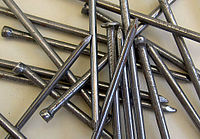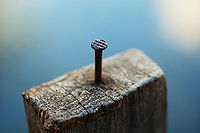- Nail (fastener)
-
In woodworking and construction, a nail is a pin-shaped, sharp object of hard metal or alloy used as a fastener. Formerly wrought iron, today's nails are typically made of steel, often dipped or coated to prevent corrosion in harsh conditions or improve adhesion. Ordinary nails for wood are usually of a soft, low-carbon or "mild" steel (about 0.1% carbon, the rest iron and perhaps a trace of silicon or manganese). Nails for concrete are harder, with 0.5-0.75% carbon.[citation needed]
Nails are typically driven into the workpiece by a hammer, a pneumatic nail gun, or a small explosive charge or primer. A nail holds materials together by friction in the axial direction and shear strength laterally. The point of the nail is also sometimes bent over or clinched after driving to prevent falling out.
Nails are made in a great variety of forms for specialized purposes. The most common is a wire nail. Other types of nails include pins, tacks, brads, and spikes.
Contents
History
Nails go back at least to the Ancient Roman period. The provision of iron for nails by King David for Solomon's Temple is mentioned in the Bible.[1] Until the end of the 18th century, they were made by hand, an artisan known as a Nailer providing them with a head and point. Until the early 17th century there were workmen called Slitters who cut up iron bars to a suitable size for Nailers to work on, but in 1590 the slitting mill was introduced to England, providing a mechanical means of producing rods of uniform cross-section. In the 19th century, after the invention of machines to make "cut nails", some nails continued to be made by hand, but the handmade nail industry gradually declined and was largely extinct by the end of that century.
Manufactured cut nails were first introduced in America at the end of the 18th century. Cut nails are machine-cut from flat sheets of steel (originally iron). They are also called square nails because of their roughly rectangular cross section. Though still used for historical renovations, and for heavy-duty applications, such as attaching boards to masonry walls, cut nails are much less common today than wire nails.
Usage
Types of nail include:
- brass tack
Brass Tacks are commonly used where corrosion may be an issue, such as furniture where contact with human skin salts will cause corrosion on steel nails.
- bullethead nail
- canoe tacks
- carpet tack
- casing - similar to finish nails but on a larger scale. It has the same diameter as a common nail.
- clout
- coil nails
- coffin nail
- corrugated
- Dheadnails
- double-ended
- fiber cement
- finish - has the same diameter as a box nail.
- horseshoe
- joist
- lost-head
- masonry - fluted nail for use in concrete
- Oval Brad
Ovals utilize the principles of Fracture Mechanics to allow nailing without splitting. Highly anisotropic materials like regular wood (as opposed to wood composites) can easily be wedged apart. Use of an oval perpendicular to the wood's grain cuts the wood fibers rather than wedges tham apart, and thus allows fastening without splitting, even close to edges.
- floor brad (aka 'stigs') - flat, tapered and angular, for use in fixing floor boards
- panel pin
- plastic strip
- gutter spikes
- roofing tack
- ring shank - nails that contain ridges along the shank to provide extra support, an example would be the HurriQuake
- shake - small headed nails to use for nailing sidewall shakes
- square
- T
- Teco - 1-1/2 x .148 shanks nails used in metal connectors (usually hurricane ties)
- veneer pin
- wire
- wire-weld collated
Sizes
Most countries, except the United States, use a metric system for describing nail sizes. A 50 x 3.0 indicates a nail 50 mm long (not including the head) and 3 mm in diameter. Lengths are rounded to the nearest millimeter.
For example, finishing nail* sizes typically available from German suppliers are:
Length Diameter mm mm 20 1.2 25 1.4 30 1.6 35 1.6 35 1.8 40 2.0 45 2.2 50 2.2 55 2.2 55 2.5 60 2.5 60 2.8 65 2.8 65 3.1 70 3.1 80 3.1 80 3.4 90 3.4 100 3.8 90 3.8 100 4.2 110 4.2 120 4.2 130 4.6 140 5.5 160 5.5 180 6.0 210 7.0 - Drahtstift mit Senkkopf (Stahl, DIN 1151)
United States penny sizes
In the United States, the length of a nail is designated by its penny size, written with a number and the abbreviation d for penny; for example, 10d for a ten-penny nail. A larger number indicates a longer nail, shown in the table below. Nails under 1¼ inch, often called brads, are sold mostly in small packages with only a length designation or with length and wire gauge designations; for example, 1" 18 ga or 3/4" 16 ga.
Penny sizes originally referred to the price for a hundred nails in England in the 15th century: the larger the nail, the higher the cost per hundred.[2][3][4][5] The system remained in use in England into the 20th century, but is obsolete there today. The d is an abbreviation for denarius, a Roman coin similar to a penny; this was the abbreviation for a penny in the UK before decimalisation.
penny size length
(inches)length
(nearest mm)2d 1 25 3d 1¼ 32 4d 1½ 38 5d 1¾ 44 6d 2 51 7d 2¼ 57 8d 2½ 65 9d 2¾ 70 10d 3 76 12d 3¼ 83 16d 3½ 89 20d 4 102 30d 4½ 115 40d 5 127 50d 5½ 140 60d 6 152 Terminology
- Box — a wire nail with a head; box nails have a smaller shank than common nails of the same size
- Bright — no surface coating; not recommended for weather exposure or acidic or treated lumber
- Casing — a wire nail with a slightly larger head than finish nails; often used for flooring
- CC or Coated — "cement coated"; nail coated with adhesive (cement) for greater holding power; also resin- or vinyl-coated; coating melts from friction when driven to help lubricate then hardens when cool; color varies by manufacturer (tan, pink, are common)
- Common — a common construction wire nail with a disk-shaped head that is typically 3 to 4 times the diameter of the shank: common nails have larger shanks than box nails of the same size
- Duplex — a common nail with a second head, allowing for easy extraction; often used for temporary work, such as concrete forms
- Drywall — a specialty blued-steel nail with a thin broad head used to fasten gypsum wallboard to wooden framing members
- Finish — a wire nail that has a head only slightly larger than the shank; can be easily concealed by countersinking the nail slightly below the finished surface with a nail-set and filling the resulting void with a filler (putty, spackle, caulk, etc.)
- Galvanized — treated for resistance to corrosion and/or weather exposure
-
- Electrogalvanized — provides a smooth finish with some corrosion resistance
- Hot-dip galvanized — provides a rough finish that deposits more zinc than other methods, resulting in very high corrosion resistance that is suitable for some acidic and treated lumber; often easier to bend than other types of nails
- Mechanically galvanized — deposits more zinc than electrogalvanizing for increased corrosion resistance
- Head — round flat metal piece formed at the top of the nail; for increased holding power
- Helix — the nail has a square shank that has been twisted, making it very difficult to pull out; often used in decking
- Length — distance from the head to the point of a nail
- Phosphate-coated — a dark grey to black finish providing a surface that binds well with paint and joint compound and minimal corrosion resistance
- Point — sharpened end opposite the "head" for greater ease in driving
- Ring Shank — small rings on the shank to prevent the nail from being worked back out often used in flooring
- Shank — the body the length of the nail between the head and the point; may be smooth, or may have rings or spirals for greater holding power
- Sinker — Same thin diameter as a box nail, length 1/8 in shorter than shown in above table, cement coated (see above), with a grid embossed on the head to keep the hammer from slipping; these are the common nails used in framing today
- Spike — a large nail; usually over 4 in (100 mm) long
Nails in art
Nails have been used in art, such as the Nail Men - a form of fundraising common in Germany and Austria around the Word War 1.
See also
- Denailer (a tool that removes used nails)
- Rail spike
- Screw
References
- ^ Bible, 1 Chronicles 22:3.
- ^ "Penny" (subscription required). Oxford English Dictionary (2nd ed.). http://ed2.oed.com/cgi/display_main/00174661#00174661-mB.V.10. Retrieved 2010-05-30. "Applied to nails, such adjectives denote the original price (in 15th c.) per hundred; as fivepenny nail, a nail which cost 5d. a hundred, tenpenny nail, a nail costing 10d. a hundred. (These names persisted after the prices fell, as they began to do in some places before 1500, and they were eventually used to designate sizes of nails.)"
- ^ H. Littlehales (1905). Medieval Rec. London City ChurchCited in the Oxford English Dictionary under "Penny" with a quote from 1426-1427.
- ^ "Penny". sizes.com. http://www.sizes.com/units/penny.htm. Retrieved 2010-01-10.
- ^ Norman Scott Brien Gras (1918). The Early English Customs System. Harvard University Press, Cambridge (MA). p. 701. Cited at sizes.com with a quote from 1507.
External links
Categories:- Fasteners
- Woodworking
- Roman Inventions
Wikimedia Foundation. 2010.




